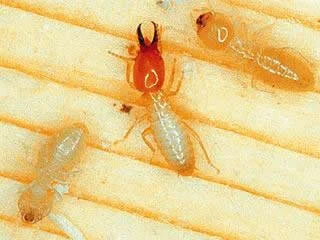
TERMITE CONTROL
One of the worst feelings you can have is as if the floor is being taken out from under you. Well, that’s exactly what a termite does. And if left unchecked, the walls and roof can follow suit. These insects occupy a very vital and important role in our environment, but we want them to steer clear of our homes and businesses. The only way to accomplish this is to have a termite specialist inspect and treat your structure with proper termiticides, baits, foams or fumigants. Luckily, we have been doing exactly that for almost 70 years. We have the knowledge, experience and materials to ensure that your structure will stay termite free for years to come.
Contact us today for a free estimate.
NATIVE SUBTERRANEAN TERMITES
“Native” subterranean termite refers to any termites of four different species found in Louisiana that are indigenous to the United States. It is difficult to distinguish between the four in the field so typically they are collectively referred to as “Natives.”
Mature native termite colonies can range in population from 50,000 to over 200,000 termites. This number is dictated by several factors, including the age of the colony, the amount and quality of the food present and the accessibility of water.
As with other subterranean species, they build their colonies under the surface of the soil and move around in tunnels excavated from the substratum. Native termites will construct shelter tubes over foundations, pipes, etc. to reach the wood within a structure or enter through direct wood-to-ground contact. Once in, they will feed on any cellulose they find in their path. That includes wood, paper, plastic and drywall.
Native subterranean termites produce winged reproductives which emerge from the colony each year in spring for the purpose of mating and creating new colonies. These alates are usually black in color with white translucent wings while still in flight. They will drop these wings once they land. Native alates usually fly during the day.
FORMOSAN SUBTERRANEAN TERMITES
Formosan subterranean termites are an invasive species that is not native to the United States. These termites were introduced into the United States in the 1940s and 1950s. Their primary conveyance was through infested crates and cargo returning from the World War II campaign in the South Pacific. And even today Formosan termites are still being introduced into new areas within the United States through the movement of infested material. This could include crates, pallets, railroad ties, rail cars, boats, trailers, potted plants, lumber, mulch, etc.
It is important to remember that Formosan termites are still a subterranean species. The main nest is usually underground, and they enter structures and homes by building shelter tubes up the foundation or through direct wood-to-ground contact. After entry into a structure they can build large nests within void spaces and also locate and exploit other sources of moisture. Once Formosan termites are established within a structure, it can be very difficult to eliminate them.
The Formosan subterranean termite nest is constructed from soil, masticated wood and saliva, and excrement. The nest will completely fill an empty void and can be very large. These nests can be the home of millions of individual termites. They are also a reservoir of moisture that can sustain the resident termites for long periods of time without other moisture sources. The most common location for these nests within a home is in the space created between the studs and the interior and exterior walls.
The numbers of termites in a Formosan termite colony can be greater than 10 million individuals. This is much greater than the numbers of termites in native termite colonies, which usually number in the hundred thousands. This enormous difference in numbers means that Formosan termites can do much more damage than native termites in a short period of time.
Formosan subterranean termites also produce winged reproductives which emerge from the colony each year from April to July for the purpose of mating and creating new colonies. These alates are usually yellowish-brown in color with white translucent wings with numerous small hairs. They will drop these wings once they land. Formosan alates do not begin to emerge until dusk and will fly until about 9 p.m.
DRYWOOD TERMITES
Drywood termites are different from other termite species in that they do not require additional sources of water. They can survive and thrive on the small amount of moisture present in "dry" wood. They can accomplish this by absorbing the moisture from their feces prior to defecation. This process creates distinctive fecal pellets that are often the indication of drywood termite infestation.
Unlike subterranean termites that usually attack structures from mature colonies in the soil, drywood termites typically enter a structure as alates during the mating season. Paired couples need only to find a suitable crack in which to conceal themselves in order to start a new colony. This makes it very difficult to prevent drywood termite infestation.
Drywood termites also prefer to maintain very clean galleries. As they live entirely within the wood that they are consuming, there is no soil present in the galleries as is found in subterranean termite colonies. They deposit their excrement far away from where they are living and eating. Often times they will create openings to the exterior of the wood and cast the waste outside. Look for piles of their fecal pellets directly below infested material.



